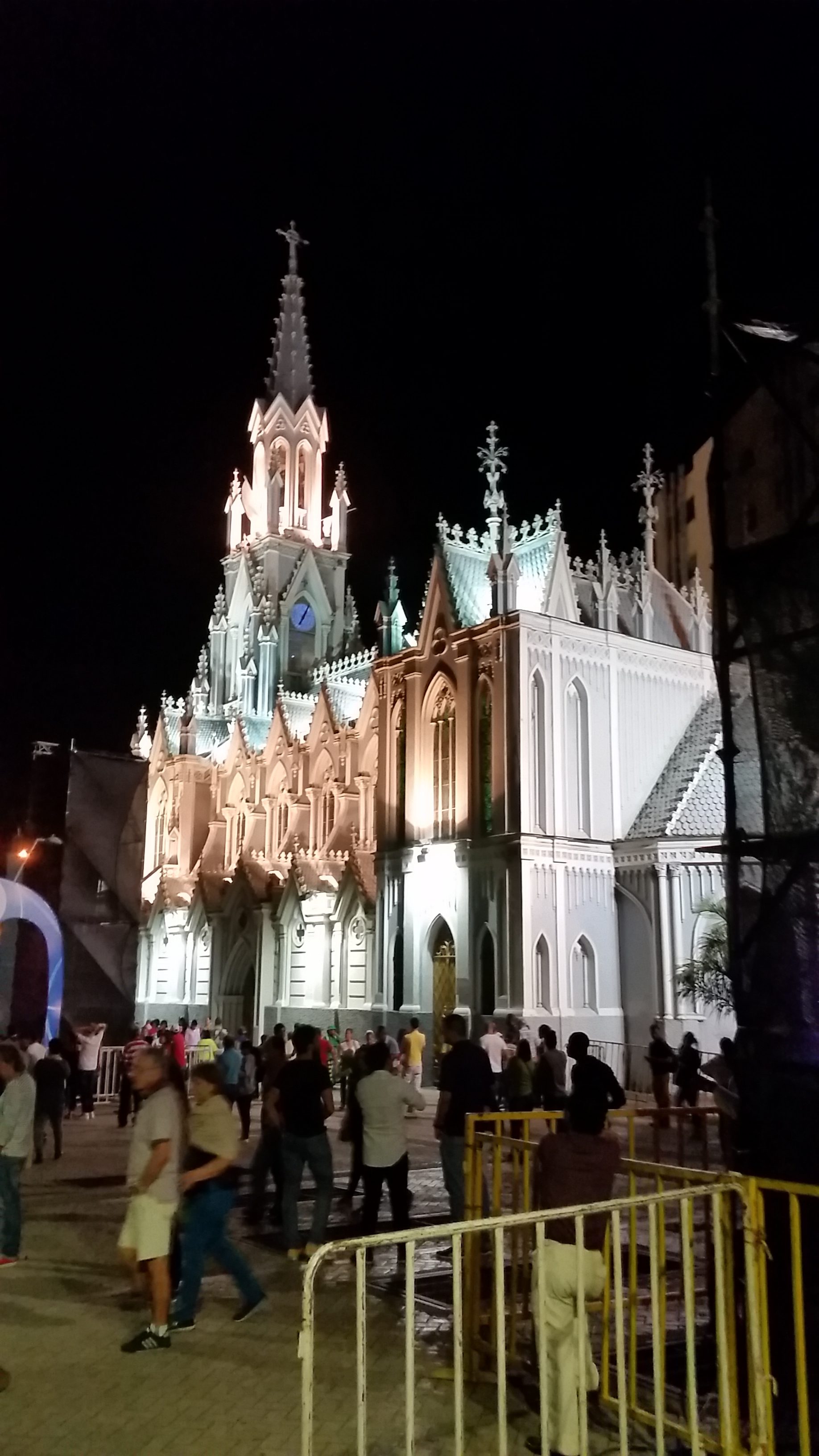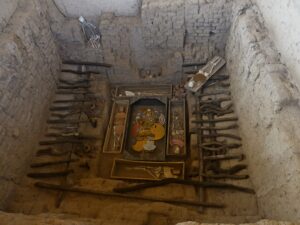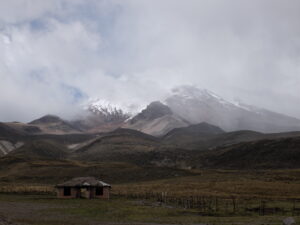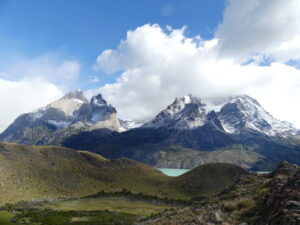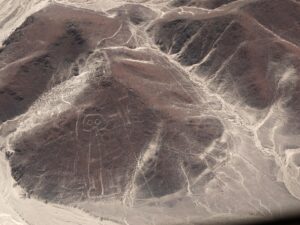
The stars peeked out from behind the soft clouds, just a few of the brightest overcoming the lights of the city. The wind was soft and refreshing in a perfect temperature for sitting on the terrace above the second level of our small hotel. Near the top of a hill and in a charming, historic district with only two-story buildings, we could see all around the city of Cali.

To the north, on the tallest hill here, three crosses shone red, green and gold. Invisible in the night were the modern communication towers behind the crosses. On the other tall mountain of Cali, the massive statue of Jesus blessing the city was also hid from view, blocked by our nearer hill.
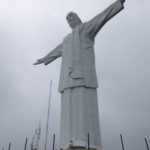
It was not cold or snowy white. Not in Colombia. It was not even Christmas Eve, but two nights before. Still, the night felt holy, though hardly silent.

Just above us, at the top of small San Antonio hill, a large crowd of worshippers attended a holiday service at the mid-18th century Chapel of San Antonio, part of an old monastery founded by Spanish missionaries. The simple chapel of white-washed stucco walls and dark cross-beams seemed simply pious in itself when we visited it the night before. A modest nativity display nearly filled the altar, similar to the others found in every Colombian church this season.
Many religious celebrations here in Cali and across the country trumpet their services far and wide into the streets with loudspeakers. And so the service atop the hill reached us on our terrace quite clearly a half kilometer away. And it echoed from the hill of the crosses as well, in a ghostly call and response.
The service continued for several hours, as we sat and talked of our day in town, savoring the pleasant night. We took time to call our children and other family members, at the moment so far away and spread across our own country. It felt like a good time to be in touch.

Earlier we had wandered around a celebration more secular than the one on the hill. Along the Cauca river, which races through the middle of town and its adjacent parks and plazas, we had found one vast party going on, centered around the main church, one that looked like a wedding-cake. Brilliantly lit displays of huge lollipop and candy decorations, as well as fanciful oversized objects like snowcones, fought for attention with myriad lights hung from the trees.

Thousands and thousands of people of all ages wandered, idled and gawked along with us at the abundant illumination. Near the center, a massive light board made the point with two phrases: Dulce Jesus Mio and Dulce Navided, or Jesus is sweet to me and Sweet Nativity.

During the day, we had found central Cali to be an odd jumble of the pleasantly old and the ugliest of new. Its outlying neighborhoods alternate between gracious, tree-lined streets and mundane areas with visual detritus. Our two-story neighborhood under San Antonio hill and chapel near the center was variously elegant and bohemian. Many hostels welcomed guests into old hacienda style buildings, each laid out around a central courtyard. Every other building, it seemed, offered a charming restaurant and diverse cuisine.
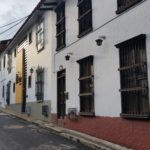
A bit away from the center, the Cauca River felt enticing despite the dense traffic adjacent to it: a fine walkway follows the tree-lined river. Along one section sit the famous cat statues, each imaginatively painted by a different artist to celebrate some quality of the town, the country or the nature of its people. The impetus for these ‘bride cats’ was an initial gift in 1996, to mark the restoration of the riverfront, by Hernando Tejada. His tall sitting cat, El Gato del Rio, still presides over this riverwalk here.
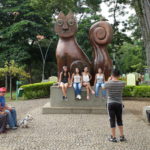
At this time of year, Cali is best known for the splendor of its Feria, the week long celebration during the days from Christmas to New Year’s. We were a few days early, but that night the party seemed in full swing already. Two stages competed for attention with lively salsa music, one near the central church and one in sprawling Simon Bolivar park a short way off, across a dazzlingly-lit bridge over the river.
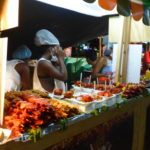
Along the river, bars and shops offered plenty to eat and drink. In the park, dozens of temporary stands presented a smorgasbord of food offerings, laid out in artful, eye-tempting displays.
Later, at San Antonio chapel above our terrace, the crowd was focused on the spiritual side of the celebration. We had observed in the prior week how much Colombians like a celebratory party, and how intensely religious they are, particularly at this season. We saw numerous churches – even in the smallest of villages – filled up to celebrate the birth of Christ, not just once a day, but throughout the day at the many masses, early and late.
As was the San Antonio chapel that night, sending its message of hope, redemption, and community loudly into the quiet night. In our otherwise peaceful neighborhood, we could feel the sacramental call flow into us – particularly as the familiar, near universal songs of Christmas closed the service.
The mellifluous tenor voice of the priest sang out into the night, doubled by its echo off the hill of crosses:
Noche de paz, noche de amor,
Todo duerme en derredor.
Entre sus astros que esparcen su luz
Bella annunciando al ninito Jesus
Brilla la estrella de paz
Brilla la estrella de paz.
And then he and the congregation added a charming little chant about el bebe, one that all clap their hands to.
And finally, delightfully voiced in a delicate tempo, the song about The Little Drummer Boy filled the air, complete with all its pa-rum-pa-pom-poms.
The music of that starry night brought us a brightness and sadness, reminding us nostalgically of Christmases past, the delight of our children when young, and of all those we loved but were not now together with. And it refreshed in us a spirit not wholly tied to Christianity. The music surpassed the moment, with its universal call for higher thoughts: illumination in the dark; attention to things more everlasting and less temporary or distracting; an embrace of the spirit of these nights; and embraces of each other.
(Also, for more pictures from Colombia, CLICK HERE to view the slideshow at the end of the itinerary page.)


